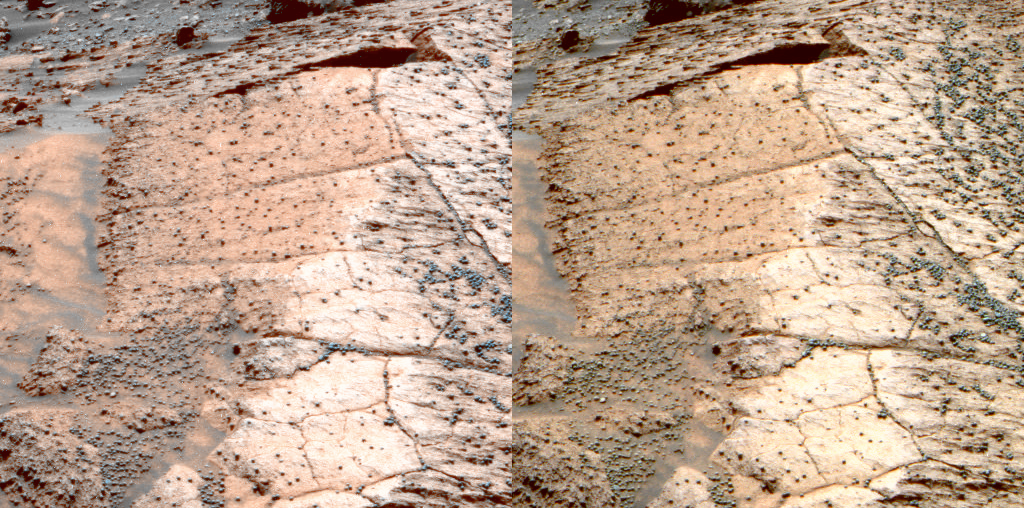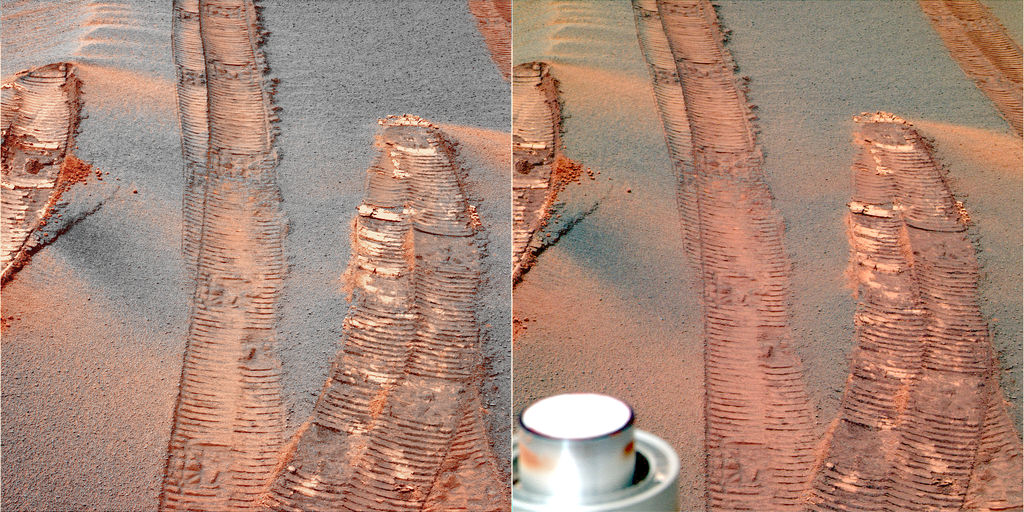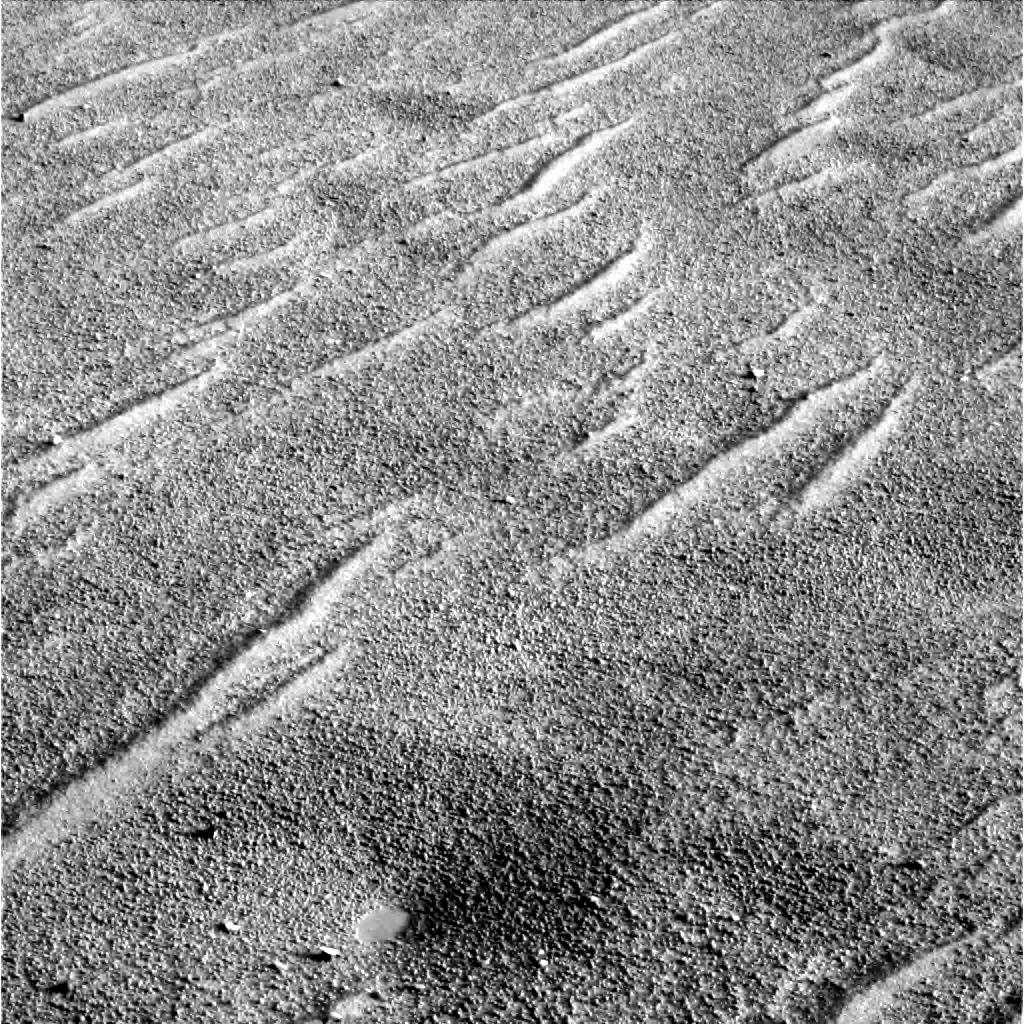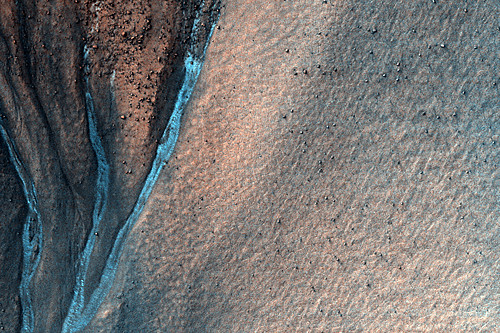New Mars Forums
You are not logged in.
- Topics: Active | Unanswered
Announcement
Pages: 1
#1 2008-04-14 09:18:43
- Vincent
- Banned
- From: North Carolina USA
- Registered: 2008-04-13
- Posts: 623
Re: Water on Mars Today
Figured I would start a new thread on water and Mars. Guess it is not hard to tell I look for life and water. They say we should. As time goes on I am less sure that we need liquid water, sunny radiation free skies and temps in the low 70’s.
I do believe that if you want a computer and space craft it would be a good thing.
We know water is on Mars. The footprints are there for liquid water. As time goes by we will find that periodic liquid water will not necessarily produce a 5’7” 115 pound shy brunette. Did I say that? If we can not interpret the visible data then we are not moving forward.
Lets understand that periodic liquid water exist on Mars
Fist image from ESA.
Now I have posted images from the rover sites of possible sub-surface eruptions. This is what we call a mega-scale eruption. We see the crack in the ground, that would be the eruption site. Area I
Area II is the progression of the shore line.
Area III is an area below the shore line with fewer craters. As the, “Rock People say, It is young.”
Vincent
Argument expected.
I don't require agreement when presenting new ideas.
-Dana Johnson
Offline
Like button can go here
#2 2008-04-17 09:28:34
- Vincent
- Banned
- From: North Carolina USA
- Registered: 2008-04-13
- Posts: 623
Re: Water on Mars Today
Wow,
The MRO image of ice in the gullies has got me all jazzed up. Looks like a water Flood.
This image is from Oppy on the edge of Victoria Crater. Looks like ground water eruption. From Hortonheardawho.
This is a stereo or cross eyed 3D. You cross your eyes to a central focal point instead of wearing the funny glasses.
Vincent
Argument expected.
I don't require agreement when presenting new ideas.
-Dana Johnson
Offline
Like button can go here
#3 2008-04-17 09:32:04
- Vincent
- Banned
- From: North Carolina USA
- Registered: 2008-04-13
- Posts: 623
Re: Water on Mars Today
One of the best mud shots ever from Hort. Just out of purgatory
Vincent

Argument expected.
I don't require agreement when presenting new ideas.
-Dana Johnson
Offline
Like button can go here
#4 2008-04-17 09:38:25
- Vincent
- Banned
- From: North Carolina USA
- Registered: 2008-04-13
- Posts: 623
Re: Water on Mars Today
Where is this water coming from you ask? From the ground, I say. Why or how you ask? I have no idea, I say.
If water was coming out we would surely catch it as long as we have been up there. I think we did.
Another Hort image of what I believe is an eruption in progress on a toasty Mars afternoon..
Vincent

Argument expected.
I don't require agreement when presenting new ideas.
-Dana Johnson
Offline
Like button can go here
#5 2008-04-17 09:46:31
- Vincent
- Banned
- From: North Carolina USA
- Registered: 2008-04-13
- Posts: 623
Re: Water on Mars Today
But if that was really water we would see erosion patterns and drainage areas? Yes, yes we would. Here is an image from inside Victoria Crater From Sir Charles III.
Looks like a drain to me. As a kicker the area is what they call Baltic sand, the best drainage in the world.
Vincent

Argument expected.
I don't require agreement when presenting new ideas.
-Dana Johnson
Offline
Like button can go here
#6 2008-04-17 11:18:06
- Vincent
- Banned
- From: North Carolina USA
- Registered: 2008-04-13
- Posts: 623
Re: Water on Mars Today
Mr. Vincent
Surly Mr. Squires would have noticed some surface changes with the MER images he released to the public.
All I got to say is yes, yes he would.
Sol 119 on left and 123 on the right. Image from Sir Charles of Xeontech.
See nothing for Vincent, just a collector of data by many names.
Vincent

Argument expected.
I don't require agreement when presenting new ideas.
-Dana Johnson
Offline
Like button can go here
#7 2008-04-17 22:37:33
- Vincent
- Banned
- From: North Carolina USA
- Registered: 2008-04-13
- Posts: 623
Re: Water on Mars Today
One more,
If there was moisture up there with all that dust then we should see other evidence of micro-climate.
All I got to say is yes, yes we would
With all that moisture on a toasty afternoon and light winds surface inversions would form in the low topographic areas. Leave bathtub rings so to speak.
Here they are.
Vincent
Argument expected.
I don't require agreement when presenting new ideas.
-Dana Johnson
Offline
Like button can go here
#8 2008-04-20 08:38:16
- Algorithms
- InActive
- From: Olympus Mons
- Registered: 2008-02-18
- Posts: 5
Re: Water on Mars Today
Vincent,
None of the images you have presented offer any evidence of extant liquid water.
At the present time we have yet to detect the extant presence of liquid water on Mars. You cannot draw the conclusion to the contrary from the images you've shared here.
To be sure, it is entirely possible that liquid water can exist at the surface ephemerally under rare conditions when atmospheric pressure and surface temperature line up. Unfortunately, the places where this is most likely to occur are also most likely dessicated for the very same reasons.
And, it is still possible we may find aquifers of liquid water beneath the surface, but, to date, the search has come up empty-handed. Neither MARSIS, nor SHARAD have detected any such aquifers. In addition, a planetwide survey by Mars Odyssey failed to turn up evidence of any extant hydrothermal activity. Gully features first found by MGS have been determined to be more likely the cause of non-aqueous action.
That's the current best state of the science. Of course, we should keep looking.
Regards,
Algorithms
Offline
Like button can go here
#9 2008-04-20 10:08:11
- Vincent
- Banned
- From: North Carolina USA
- Registered: 2008-04-13
- Posts: 623
Re: Water on Mars Today
Algorithms,
The above images show an active process that can not be explained by wind and dust alone.
The current theoretical model does not allow for surface water eruptions in this area even though the visible data shows obvious liquid activity. Your rubber stamp response is based on this model.
Being as we have limed knowledge of the underground water works of Mars and surface interaction your conclusion is hypothetical at best. If you have evidence of some other medium that looks like water and behaves like water then please post.
Regards,
Vincent
Argument expected.
I don't require agreement when presenting new ideas.
-Dana Johnson
Offline
Like button can go here
#10 2008-04-21 22:38:19
- Algorithms
- InActive
- From: Olympus Mons
- Registered: 2008-02-18
- Posts: 5
Re: Water on Mars Today
Vincent,
Not to be disrepectful, but you are mistaken. There is nothing about the features in the images you have presented that require an extant aqueous explanation. More importantly, the sub-surface radar instruments aboard Mars Express and MRO have both failed to detect any subsurface aquifers. And, after an exhaustive search, Mars Odyssey failed to find evidence of any extant hydrothermal activity on Mars.
Sincerely,
Algorithms
Offline
Like button can go here
#11 2008-04-23 04:08:44
- Vincent
- Banned
- From: North Carolina USA
- Registered: 2008-04-13
- Posts: 623
Re: Water on Mars Today
Algorithms
I believe they do, Mars is a strange place indeed. It is of course my opinion.
To be sure, it is entirely possible that liquid water can exist at the surface ephemerally under rare conditions when atmospheric pressure and surface temperature line up. Unfortunately, the places where this is most likely to occur are also most likely dessicated for the very same reasons.
Well in regard to pressure the rovers were not equipped with any meteorlogical equipment so pressures are not known. Pathfinder never had any pressures below 6.1 millibars and if topography is any indication then the area where Oppy landed is in the topographic area for these pressures to be even higher.
As far as why these areas are desiccated for the very same reasons I have no idea what you are talking about. Maybe you can explain.
As far as the MRO and Mars express I would love to get some links to those reports.
Thanks,
Vincent
It may just be a dust puddle.
Argument expected.
I don't require agreement when presenting new ideas.
-Dana Johnson
Offline
Like button can go here
#12 2008-04-28 15:37:48
- Vincent
- Banned
- From: North Carolina USA
- Registered: 2008-04-13
- Posts: 623
Re: Water on Mars Today
Well is it a dust puddle? I thank not.
Vincent
Argument expected.
I don't require agreement when presenting new ideas.
-Dana Johnson
Offline
Like button can go here
#13 2008-05-01 08:13:28
- Vincent
- Banned
- From: North Carolina USA
- Registered: 2008-04-13
- Posts: 623
Re: Water on Mars Today
I spent some time looking at the dust puddle above and decided we needed a colorized stereo 3D
Vincent

Argument expected.
I don't require agreement when presenting new ideas.
-Dana Johnson
Offline
Like button can go here
#14 2008-05-01 10:15:11
- Vincent
- Banned
- From: North Carolina USA
- Registered: 2008-04-13
- Posts: 623
Re: Water on Mars Today
It is time to get into some hardcore science. They give use the visible data, lets interpret.
Mars is a world of dust and wind primarily. The interaction of water in whatever phase change would be easily seen. This is indeed the case. If you can imagine a world of damp areas with wind blown dust then you should expect to see the image below.
Micro-climate, stratification and water inducted reincorporation is the only answer to this visible image.
Moisture in the low topographical areas would stratify. Wind transported or accumulated atmospheric dust would be reincorporated into the surface material in a highly saturated state. These areas would be presented in a ringed display showing the history of all events. How simple can it get.
See the water, brother.
A 3D from Hort
Vincent

Argument expected.
I don't require agreement when presenting new ideas.
-Dana Johnson
Offline
Like button can go here
#15 2008-05-05 09:29:43
- Vincent
- Banned
- From: North Carolina USA
- Registered: 2008-04-13
- Posts: 623
Re: Water on Mars Today
Now to understand the mechanism for water eruptions on the surface of Mars is complex. The Earth is in its infancy still with tectonics and molten lava not very far down from the surface.
On Mars we must scratch our heads about such genesis of process. Is it CO2 driven or volcanic from a lower level. The truth is you can not have eruptions without propellant. We should see dry eruptions if these events are gas driven. I think this image speaks for its self. If you want eons of wind and dust then Opportunity would have never seen this image.
You can not have your cake and eat it too. At least that’s what my first wife told me. A 3D stereo from Hort.
Image 
Argument expected.
I don't require agreement when presenting new ideas.
-Dana Johnson
Offline
Like button can go here
#16 2008-05-09 08:36:11
- Vincent
- Banned
- From: North Carolina USA
- Registered: 2008-04-13
- Posts: 623
Re: Water on Mars Today
While we are waiting for Phoenix to land and the boys sweat the freefall we might as well go over some old data and find out where that water is. Now as you guys get to know me you will hear me complain, cry or whine about limited data.
When the MRO went into orbit around Mars the anticipation of having a high resolution imager was palpitable. The Wednesday release was the most exciting day, I would get up early and put on some coffee with a towel to wipe the drool. Now I do not check it unless I am really board. Defrosting dunes and buttes with anything interesting hidden behind a false color haze. A bone for the doggy, here boy.
Now you would think that a scientist would point that imager at some of the most controversial images from past missions like the one I will discuss here. I believe they have and not released the data, I will give you guys a personal example.
In 1980 the Storm track was far south and several 100 year storms developed off Cape Hatteras, I was a young surface observer at NAS Norfolk Va. The biggest storm hit on March 3 through 6. I walked 5 miles to my post in visibility less than 1/8 mile, winds 0340G65, temp 14F. I received a letter of Recognition. My EO said it was a waste of paper, they could not have kept me away with a stick. That is indeed correct.
Now lets find that water.
This is one of the more famous images of water eruptions on the surface of Mars dubbed, “Lake Stedman.” Lake is incorrect as these events are transitory. Analysis to follow
Vincent
Image 1-1

Argument expected.
I don't require agreement when presenting new ideas.
-Dana Johnson
Offline
Like button can go here
#17 2008-05-09 09:12:01
- Vincent
- Banned
- From: North Carolina USA
- Registered: 2008-04-13
- Posts: 623
Re: Water on Mars Today
How do we know this is not a lake?
Lake is an Earth term were collections of water in pools is stable for long periods of time. This not the case here so I will debunk any notion.
First we know an eruption of liquid water has taken place because of change in characteristic of the surface material. Now keep in mind we are not talking pure or potable water. It is most likely a brine with unknown acidity.
The first image will show transitory nature as craters are visible in the gravity induced leveling. This would indicate long periods between large scale eruptions with smaller surface eruptions like have been seen at Meridiani the normal state. This is still an active area
Phase change would be seasonal dependant with surface dust and micro-dune activity clearly visible between events
Area I- This shows a crater that has been consumed below the water line. This proves that this is not a lake but a major water eruption in geological time. Another Geologist spanking for sure. It is clear they left their mark on my education.
Area II- This clearly shows shore lines and islands, current event.
Micro-climate and associated mineralogical or biological manifestation to follow.
Vincent
Image 2-2

[/img]
Argument expected.
I don't require agreement when presenting new ideas.
-Dana Johnson
Offline
Like button can go here
#18 2008-05-09 11:01:38
- Vincent
- Banned
- From: North Carolina USA
- Registered: 2008-04-13
- Posts: 623
Re: Water on Mars Today
The next step is to explain the difference in the surface image
Area I- Obvious change. Is it a SW wind over micro-climate and mineralogy or biology?
Area III- It is not happening SW of the event.
Area II.- evidence of Micro-climate and change of surface visibility on a meso-scale
Vincent.
Image 
Argument expected.
I don't require agreement when presenting new ideas.
-Dana Johnson
Offline
Like button can go here
#19 2008-05-19 10:34:20
- Vincent
- Banned
- From: North Carolina USA
- Registered: 2008-04-13
- Posts: 623
Re: Water on Mars Today
Part 1
Now we rarely get a take on water process on Mars from different prospective, we did hear
The first is a MOC image that first showed a possible liquid component to the equation. Now as in previous rants and more to come gray-scale will give us some interpretation of image but what is dust and what is snow is left out of the equation, Thanks NASA. I recon use regular guys must put together the pieces.
In this image we see disturbance at the crater rim, erosion patterns and pooling at the crater floor. No thermal or pressure data accompanies this image.
Image 1

The second image is a MRO image of a similar crater rim feature,
Image 2

The third image is a context image of the above
Image 3
Vincent

Argument expected.
I don't require agreement when presenting new ideas.
-Dana Johnson
Offline
Like button can go here
#20 2008-05-19 10:41:27
- Vincent
- Banned
- From: North Carolina USA
- Registered: 2008-04-13
- Posts: 623
Re: Water on Mars Today
Part 2
Now we know that time for process on Mars is not like time on Earth and wind is the main atmospheric event. Sublimation is the main phase change event and wind sculpting would be evident, it is or will be. Water ice or slurry. Slurry is just a combination of water and dust, or mud.
The rover gave us a hint of what water eruptions would look like. This is from Opportunity sol 101. It is a lot warmer here but still damn cold.
Ice Dunes or slurry in Endurance Crater
Image 4

The next image shows my analysis of phase change in accordance with mass and expected change of photon reflection. Photon reflection is what causes glint and rainbows.
Area I- This area shows high definition between surface material and dune material with photon reflection evident. This would mean there is something in the dune that changes its characteristics with both the surface and the interaction with light.
Area II- This area shows a return to surface material characteristic with no photon reflection. This being smaller with less mass would be first to sublimate or melt. It did. If water Ice was present and is no longer there, then photon reflection would dissipate. It did.
Area III- This is just a repeat showing that the process in area II was no fluke.
Vincent
Image 2

Argument expected.
I don't require agreement when presenting new ideas.
-Dana Johnson
Offline
Like button can go here
#21 2008-05-19 11:45:22
- louis
- Member
- From: UK
- Registered: 2008-03-24
- Posts: 7,208
Re: Water on Mars Today
Thanks for all these wonderful pics! I'm not qualified to speak on the water issues but those pics just make me feel so sad in some ways...here is the beautiful other world and no one on this planet is prepared to stump up the cash to go visit it properly and bring back the most amazing holiday video ever (and at the same time start a new human civilisation).
Surely, surely someone will before long embark on this adventure of the century.
Let's Go to Mars...Google on: Fast Track to Mars blogspot.com
Offline
Like button can go here
#22 2008-05-19 11:58:06
- Vincent
- Banned
- From: North Carolina USA
- Registered: 2008-04-13
- Posts: 623
Re: Water on Mars Today
Louis,
Qualification is a relative term. As a regular guy, I would say you did a fine damn job.
Vincent
Argument expected.
I don't require agreement when presenting new ideas.
-Dana Johnson
Offline
Like button can go here
#23 2008-05-24 17:15:15
- Vincent
- Banned
- From: North Carolina USA
- Registered: 2008-04-13
- Posts: 623
Re: Water on Mars Today
Nutty rant 1247-14d
I added the word nutty because some folks think they are
Now I will post a bound hydrogen map of Mars What bonds with hydrogen? Oxygen.
That would be water boys. If you look at the phoenix site you will see it is a sweat spot. I will post that to
Now the rant, It will be a good one. Scientist chime in at any time. I always wanted to say that.
Now planetary formation is dependent on temperature in regard to coagulation.
Fist Metal, second rock and third Ice
Time is an opportunistic phase in each realm that developed the terrestrial planets Venus, Earth and Mars.
The Gas Giants Jupiter and Saturn and you heard it here first, then the Ice giants Uranus and Neptune. Thy are ice brother
When the solar system formed you had to get out past Mars for it to be cool enough for water to form. The gravitational flux between Jupiter and Saturn sent the Ice laden Asteroids to the Terrestrial planets to supply water. 3.9 million years ago. The great bombardment they call it.
That is the basics. If you guys want to go deeper, chime in
Vincent
Image 1

Image 2

Argument expected.
I don't require agreement when presenting new ideas.
-Dana Johnson
Offline
Like button can go here
#24 2008-05-25 10:44:02
- Zydar
- Member
- From: UK
- Registered: 2007-08-14
- Posts: 74
Re: Water on Mars Today
I believe that when the volcanic magma diminuished it left huge underground voids and the water of the northern ocean drained away into the voids. That's the reason there is not much evidence of it to be seen on the surface.
I believe that now the majority of the water from the ocean is under the surface. It could not have floated off into space as it has mass and is affected by the gravitational forces being exerted upon it. So, the place to find most of the water is not on the surface but under the surface.
Zydar
Offline
Like button can go here
#25 2008-05-26 05:10:48
- Vincent
- Banned
- From: North Carolina USA
- Registered: 2008-04-13
- Posts: 623
Re: Water on Mars Today
Zydar,
The water is indeed underground with occasional eruptions on the surface that are transient.
Vincent
Argument expected.
I don't require agreement when presenting new ideas.
-Dana Johnson
Offline
Like button can go here
Pages: 1